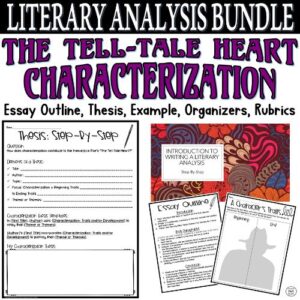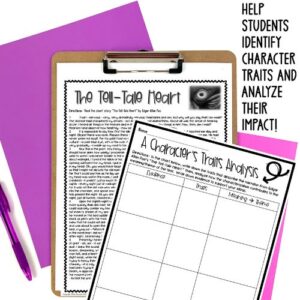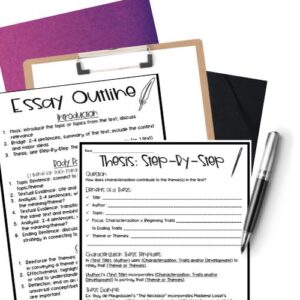We want our students to become critical thinkers who read, examine, and write about the significance of whatever text they come across throughout their lives. But how do we do that? Literary Analysis is not an easy topic, usually because most of us don’t take classes about it or see very many literary analysis examples.
We do, however, read and examine texts all of the time! We break down, analyze, and discuss what we watch, read, or listen to every day, and so do our students. Because we do this, we can teach our students the same process but for literature in our classrooms.
We can use literary analysis examples to model what we want in 5 No Sweat Steps!
Need help with Test Prep? Check out this FREE Pack of 3 Test Prep Activities to help students achieve success on standardized tests!

5 NO SWEAT STEPS for Teaching With Literary Analysis Examples
#1 START WITH THE END IN MIND
What do you want your students to be able to do? Well, it depends on the students. When it comes to elementary students, you can start with a focus on theme. Say we read “The Ugly Duckling” or “The Little Mermaid.” We can focus on having students write a paragraph on how characterization leads to theme. In any fairy tale or fable, there is always a message. It makes the literary analysis quite simple then.
Your short response directions that contain literary analysis examples can include the following:
How does “The Ugly Duckling” change? How does this change contribute to the theme in the story?
IDEAS FOR A FINAL PRODUCT
- ELEMENTARY: Students can write a paragraph for a Short Response. Your goal is to simply introduce what it means to think deeply about a text. Start with a fairy tale or fable, so the students have an easier time discussing the message of the story.
- MIDDLE SCHOOL: Students can write 2 paragraphs with a focus on a theme using an example for each paragraph. It can be based on a poem or short story!
- HIGH SCHOOL: Students can write a full-blown essay, but you can have it focused on 4 paragraphs, 5 paragraphs, or a 5-page essay 😉 It is up to you! You can even differentiate depending on what your students need!
Read here for activity ideas >>> The Tell Tale Heart Edgar Allan Poe At His Best!
You can focus on whatever you want for your literary analysis! If you want to differentiate, you can have groups of students choose their own topic, or you can assign a focus to students. You will, however, have to define and then explain what the focus is before moving on. If you want to analyze conflict, explain the 4 types (man vs. man, man vs. society, man vs. nature, and man vs. self) and the 2 types (internal and external) first. Here are some ideas for literary analysis:
- Plot: exposition, rising action, climax, falling action, resolution
- Literary Devices: similes, metaphors, allusions, hyperbole, etc.
- Characterization: traits or development
- Setting: beginning, middle, end
- Conflict: types of conflict (4), external/internal conflict
- Literary Criticism: gender, feminism, critical race theory, etc.
#3 READ WITH A FOCUS
You will have to model what you want as you read by using literary analysis examples. For instance, if you are reading “The Tell-Tale Heart” by Edgar Allan Poe, you can focus on analyzing characterization. Read through the first part of the story and have students identify traits of the protagonist. 1. Underline the evidence. 2. Think aloud about it. 3. Annotate for meaning. What is he saying or doing? Then, explain by doing your own analysis. Answer this question: What does this MEAN?
HERE IS A LITERARY ANALYSIS EXAMPLE
Click to read about TEACHING WITH MOVIES IN MIDDLE AND HIGH SCHOOL!
#4 USE A LITERARY ANALYSIS ORGANIZER
Students need help with organization. Don’t we all though? I encourage you to use a simple graphic organizer to help in this process. Have students go back to their own annotations for help. The graphic organizer should include the following: The Literary Analysis Focus, The Evidence, and The Meaning/Message/Theme Connection. Be sure to use literary analysis examples before beginning. Providing 1 or 2 examples will help students go a long way!
#5 USE A TEMPLATE
Now that students have their organizer with their literary analysis examples already written, they can accomplish whatever you want. (Be sure to look at literary analysis examples before you start having them write their own. You can use examples you have created or examples from different sources.) If you want them to write a short response, provide a sentence-by-sentence outline.
Or if you want them to write 2 paragraphs for their literary analysis examples, help them with breaking down the paragraphs into smaller parts. Additionally, if you want them to write an essay, provide an outline that will help them to develop their ideas as they go along. If students don’t have a basic template, they may not know what to write. I suggest starting with an introduction, 2 body paragraphs, and a conclusion for a beginner literary analysis.
Click below for help with teaching “The Tell-Tale Heart” through literary analysis examples!
Don’t shy away from teaching literary analysis! Students need the exposure and the practice to think deeply about the meaning and message of anything they come into contact with. Through this step by step process and several literary analysis examples, all students can become literary connoisseurs!
Need more ideas for English Lesson Plans for Teachers? Check out my store Kristin Menke-Integrated ELA Test Prep!





